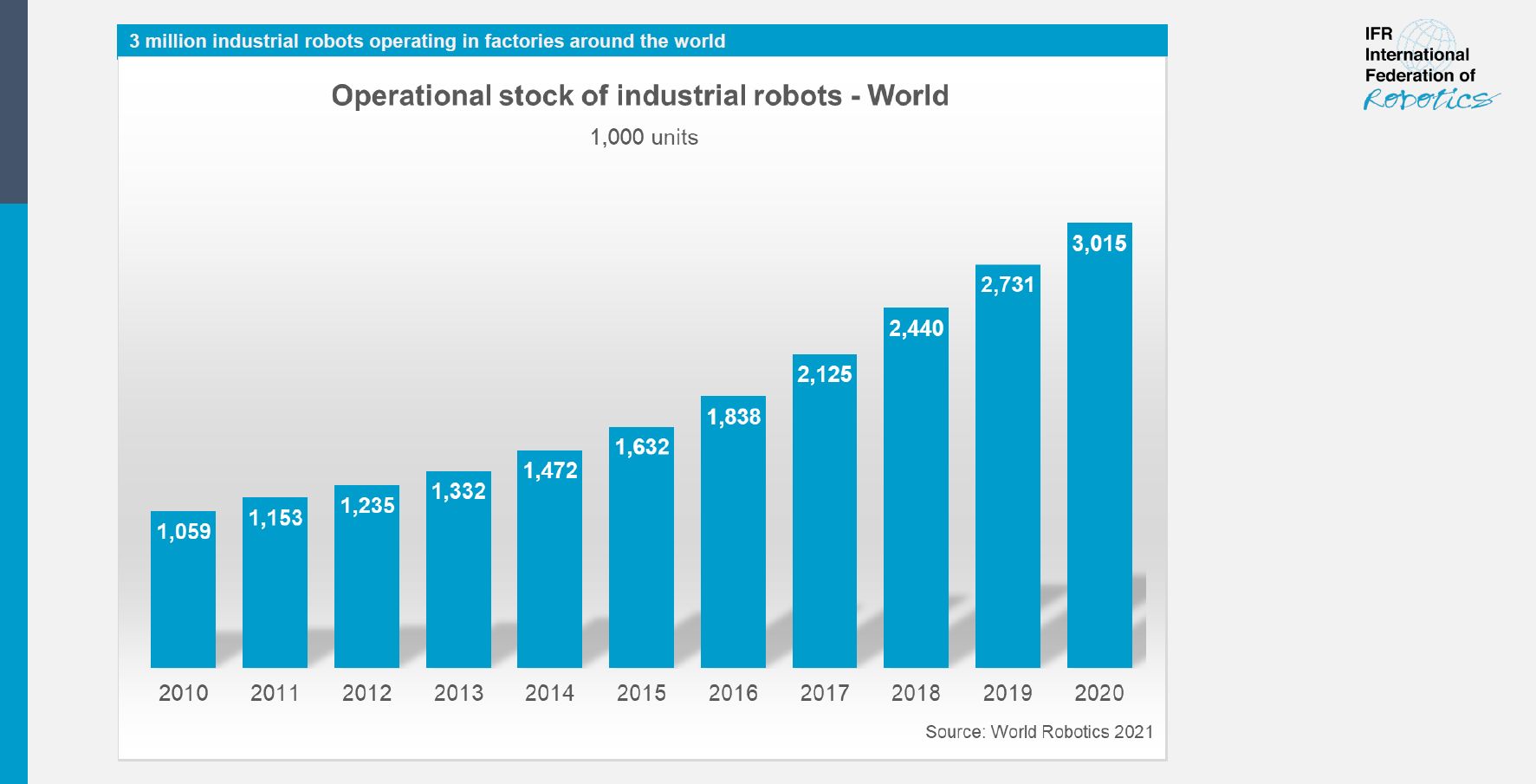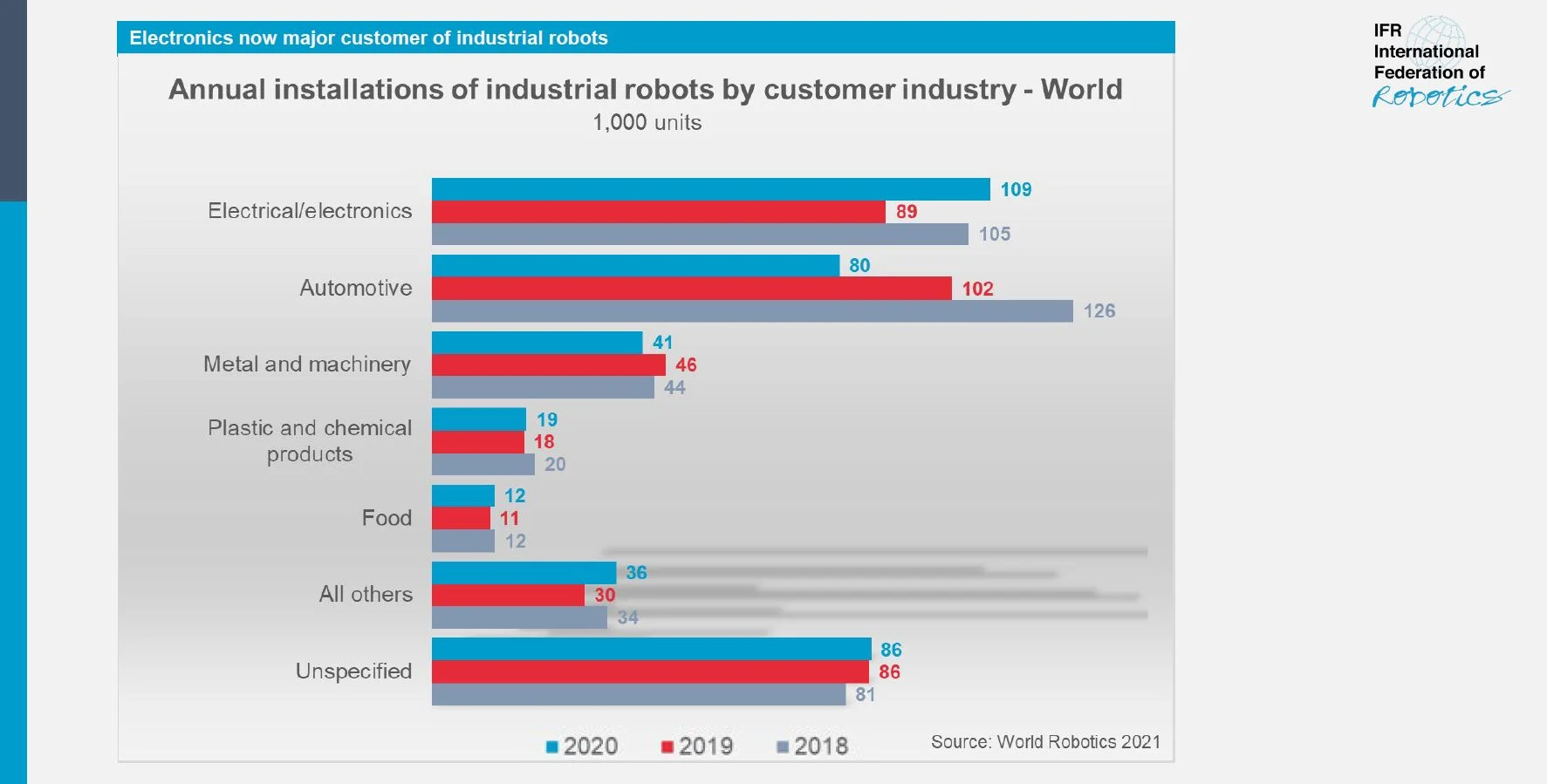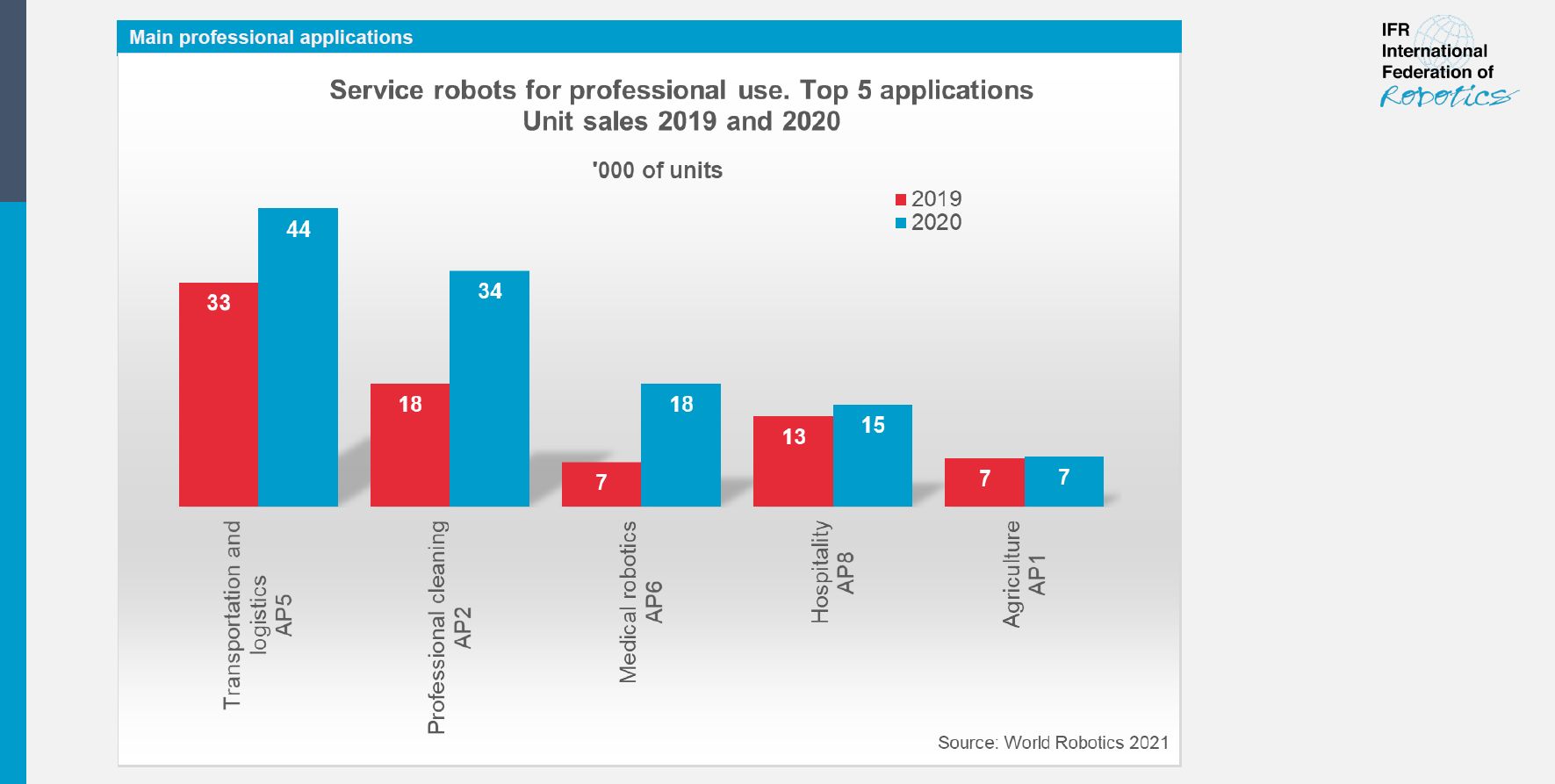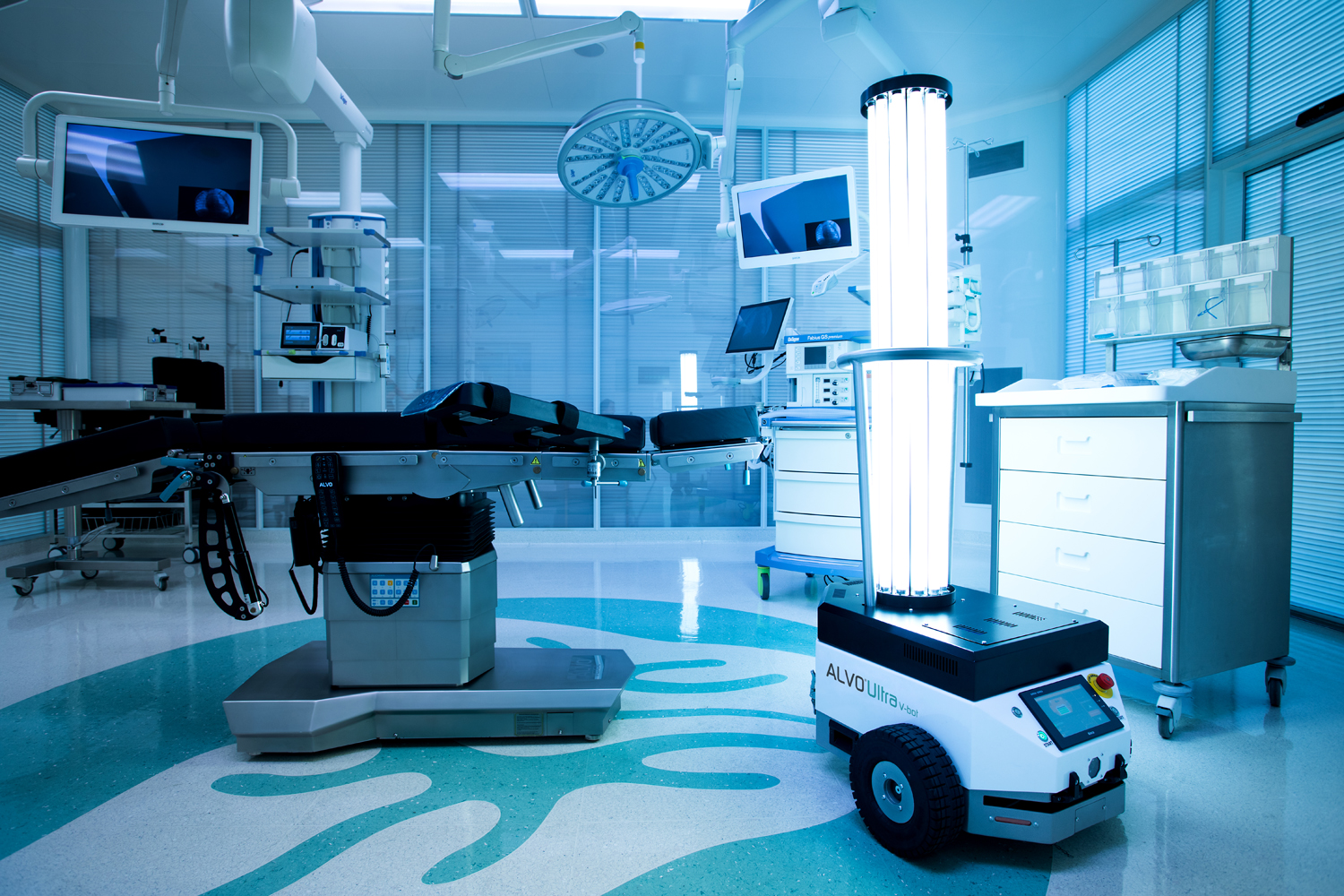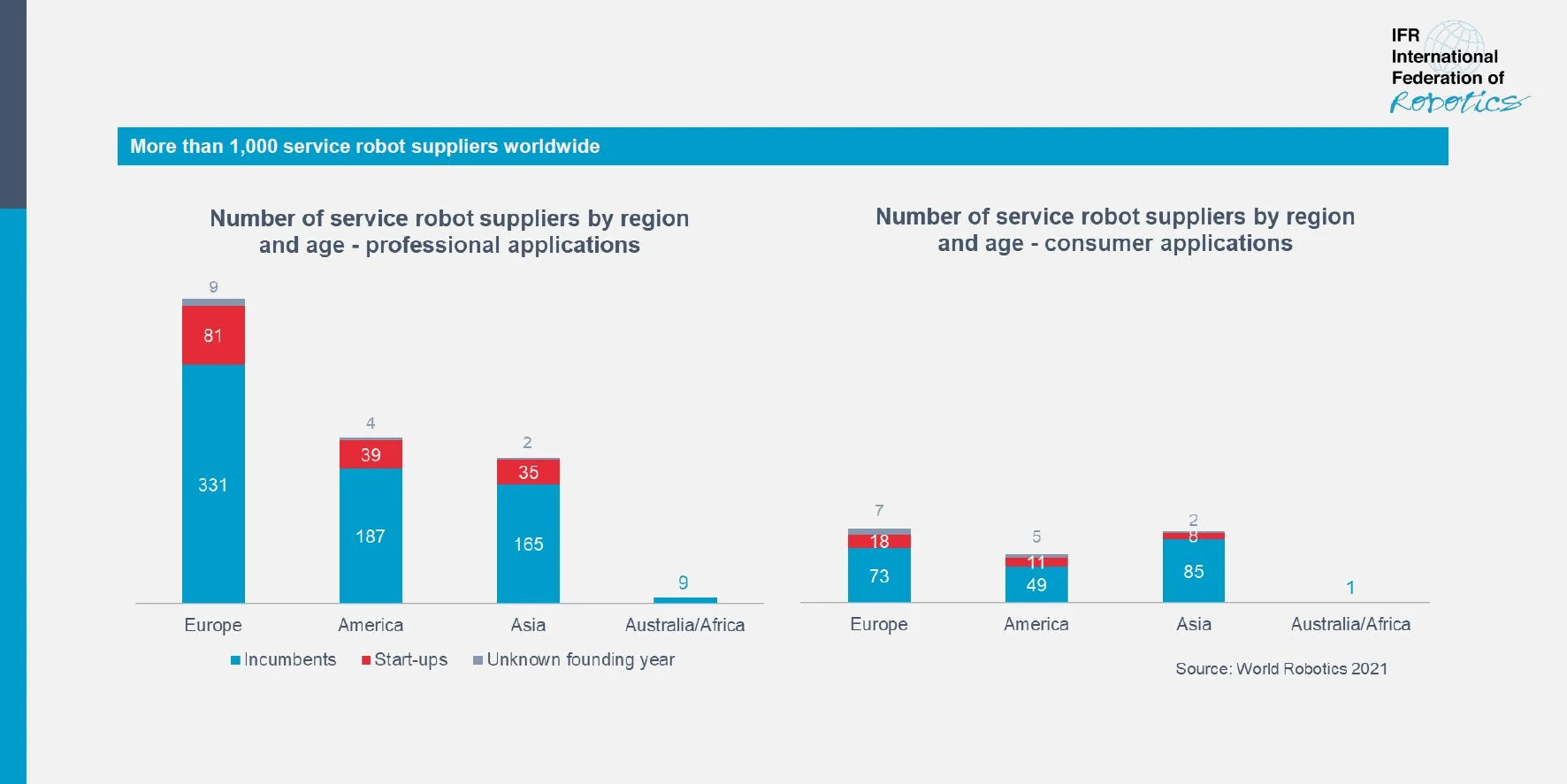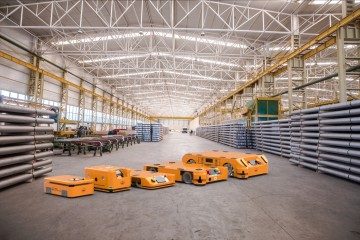
In industrial production, the trend of implementing industrial robots is becoming more and more common wherever high repeatability, quality and efficiency are required, as this translates into an increase in productivity and a significant reduction in costs.
Robotization in the world
This is confirmed by the results of the World Robotics 2020 report opublikowanego w listopadzie przez Międzynarodową Federację Robotyki. Pomimo pandemii widoczny jest trend wzrostowy (+10%) wyrażany w liczbie działających na świecie robotów – jest ich obecnie ponad 3 miliony. Wskaźnik gęstości robotyzacji wynosi obecnie 126 (na 10 tys. pracowników) – w 2018 roku wskaźnik ten wynosił 99. Na ten wynik duży wpływ miały rynki azjatyckie, gdzie wdrożono 71% wszystkich nowych robotów, z czego aż 20% w Chinach.
Fig.1. The total number of robots working in the world - 1,000 units
In Europe, where there were the fewest implementations compared to the rest of the world, most installations took place in Germany, Italy and France. The upward trend is also visible in Poland (despite a slight decline in 2020) and Central and Eastern Europe, where, despite the initial slowdown caused by the pandemic, interest in process automation and robotization is growing. This is due to, among others, from the decreasing number of manual workers, the outflow of qualified workers to Western markets, the increase in labor costs, as well as unfavorable demographic changes (fewer and fewer people of working age).
Fig. 2. Annual industrial robot installations by customer industry - World - 1000 units
There is also a growing interest in robotization in small and medium-sized enterprises that have problems with maintaining production continuity due to the human factor. This is confirmed by the data in the report, which shows a change in the proportion of implementations in industries - a decline in the previously dominant automotive industry and an increase in other sectors, especially electrical, electronic, metal and machine production. IFR predicts growth of 13% in the next five years.
Boom in the service robots market
The results of the reportWorld Robotics 2021 – Service are even more interesting Robots, do których zaliczane są m.in. roboty mobilne AMR i wózki AGV. W 2020 roku rynek robotów do usług profesjonalnych osiągnął na całym świecie obroty w wysokości 6,7 mld USD, tym samym zanotował wzrost o 12%.
The coronavirus pandemic undoubtedly had an impact on this dynamic growth, as can be seen in the five most important trends in the use of professional service robots:
- AMR and delivery robots – the need for flexible solutions;
- cleaning and disinfection - +50 companies presented solutions in response to the pandemic;
- medical and rehabilitation – the need for individual support;
- social robots – telepresence – especially due to the pandemic;
- automatic restaurants – service support, reduction of personal contacts due to the pandemic.
Fig.3. Service robots for professional use. Top 5 apps. Unit sales 2019 and 2020
It is worth emphasizing that as many as one in three units were built to transport goods or cargo. According to IFR, most units of autonomous mobile robots sold operate in indoor manufacturing and warehouse environments. The trend is towards flexible solutions for AMRs to work together in mixed environments, including: with the help of forklifts, other mobile robots or people.
This is also confirmed by inquiries and implementations of MOBOT® mobile robots which increasingly work in a very dynamic environment, transporting loads in traffic routes where forklifts and people are also present.
There is also a large market potential for transport robots in outdoor environments and public traffic, including: last mile delivery. However, further development in this area will be largely influenced by legal regulations in individual countries, which currently effectively prevent it.
A large increase, by as much as 92%, was also recorded in the case of cleaning robots, of which 34,400 units were sold. In response to the increasing hygiene requirements caused by the Covid-19 pandemic, over 50 service robot suppliers have developed disinfection robots that spray disinfectant liquids or use ultraviolet light.
Fig.4. ALVO® Ultra V-bot - mobile robot for UV-C disinfection
These solutions included, among others: ALVO® Ultra V-bot developed by ALVO® Medical, in cooperation with technological partners: WObit and Luxiona. The Mobile UV-C disinfection robot ensures high decontamination efficiency in all important public spaces: concert halls, schools, production plants, sports clubs, shopping centers, laboratories, etc.
IFR indicates thatdisinfection robotsin hospitals and other public places have great potential. Unit sales of professional cleaning robots are expected to grow at an average double-digit rate each year from 2021 to 2024.
The global Sars-CoV-2 pandemic has created additional demand forsocial robots. The need for their implementation is especially great in nursing homes, where they serve residents to keep in touch with friends and family members in times of social distancing. In public places, robots perform an information and communication function by providing information to avoid human contact in person, and they also connect people via video at business conferences or assist with maintenance tasks on factory floors.
The demand for hotel robots has also increased, providing, among others, food or bedding for rooms - the turnover in this industry amounted to USD 249 million. Double-digit annual growth in this area is expected.
The increasing trend also applies toservice robots for consumer use, among which the most popular are robots for homework (vacuum cleaners and other robots for cleaning floors). In 2020, almost 18.5 million units were sold (+6%), worth USD 4.3 billion. This is due to, among others, due to the very high availability of these solutions. Gardening robots are also popular, especially lawn mowing. In the coming years, the consumer service robot market is expected to grow at an average double-digit rate each year.
Fig.5. On the left - Number of service robot suppliers by region and market experience - professional applications
Right - Number of service robot providers by regionmarket internship- consumer applications
Interestingly, 80% of service robot suppliers have been on the market for over 5 years, of which 47% come from Europe, 27% from North America and 25% from Asia.
The market for robotization of autonomous vehicles is growing
The dynamic growth of the autonomous mobile robots market is also confirmed by the latest report Autonomous Mobile Robots Market opublikowany przez Verified Market Research. W tym opracowaniu rynek robotów AMR został wyceniony na 2,1 mld dolarów w 2020 r., a w 2028 r. ma on osiągnąć poziom 8,7 mld dolarów, przy rokrocznym wzroście na poziomie 18,7%.
The driving factors for the market presented in the report include the growing use of robots in various industrial sectors, technological progress, the growing application area of autonomous vehicles and the increasing awareness of the benefits of autonomous robots. These are machines designed to perform specific actions and behaviors. Using autonomous navigation and other functionalities, AMR robots perform tasks without human assistance (artificial intelligence), are easy to adapt to new tasks, and are safe for people, property and the environment.
Thanks to these features, mobile robots constitute a very flexible solution for carrying out tasks in various industries. The Verified Market Research report points in particular to the development of IoT in the automotive industry, as well as the expectation from users accustomed to a digital lifestyle that it will be transferred to the car with the help of Internet of Things technology.
Summary and outlook
The common denominator of all the studies presented above is the worldwide popularization of robotization observed by researchers, especially regarding the service robots market. It results, as indicated earlier, from the need to improve processes, reduce production costs, and increase production efficiency. The need to invest in robotization was also influenced by the Covid-19 pandemic, which caused an increasing shortage of qualified employees and instability in maintaining the continuity of production due to the human factor. All reports unanimously predict an increase in investments in robotization in the coming years, which will not be affected even by temporary shortages of components and raw materials.
Are you interested in the article? Want to learn more about mobile robots and how they can improve processes in your company? Don't hesitate andcontact our advisor.
Sources:
https://ifr.org/ifr-press-releases/news/robot-sales- rise-again
https://ifr.org/ifr-press-releases/ news/service-robots-hit-double-digit-growth-worldwide
https://www.verifiedmarketresearch.com/product/autonomous-mobile-robot-market/
Did you get interested in this article?
If you have any question contact our specialists.

